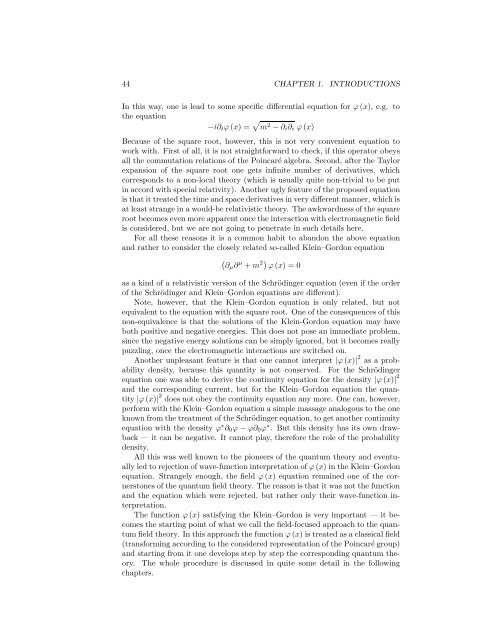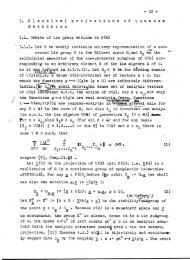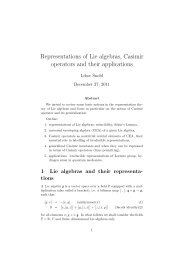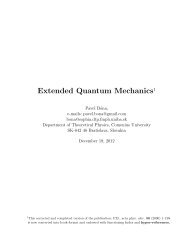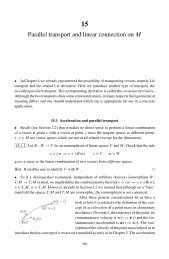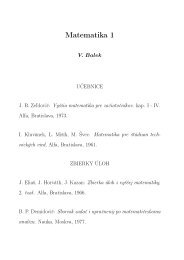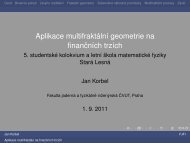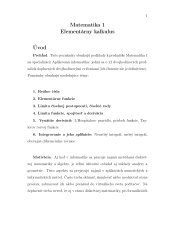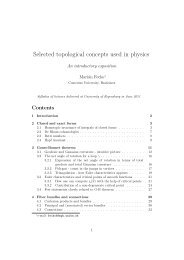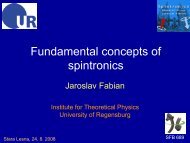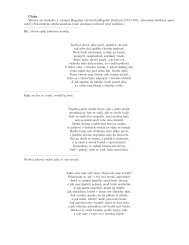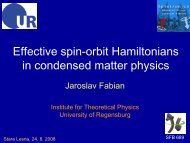Quantum Field Theory I
Quantum Field Theory I
Quantum Field Theory I
Create successful ePaper yourself
Turn your PDF publications into a flip-book with our unique Google optimized e-Paper software.
44 CHAPTER 1. INTRODUCTIONS<br />
In this way, one is lead to some specific differential equation for ϕ(x), e.g. to<br />
the equation<br />
−i∂ t ϕ(x) = √ m 2 −∂ i ∂ i ϕ(x)<br />
Because of the square root, however, this is not very convenient equation to<br />
work with. First of all, it is not straightforward to check, if this operator obeys<br />
all the commutation relations of the Poincaré algebra. Second, after the Taylor<br />
expansion of the square root one gets infinite number of derivatives, which<br />
corresponds to a non-local theory (which is usually quite non-trivial to be put<br />
in accordwith specialrelativity). Another uglyfeature ofthe proposedequation<br />
isthatittreatedthetimeandspacederivativesinverydifferentmanner, whichis<br />
atleast strangein a would-berelativistictheory. The awkwardnessofthe square<br />
rootbecomesevenmoreapparentoncethe interactionwithelectromagneticfield<br />
is considered, but we are not going to penetrate in such details here.<br />
For all these reasons it is a common habit to abandon the above equation<br />
and rather to consider the closely related so-called Klein–Gordon equation<br />
(<br />
∂µ ∂ µ +m 2) ϕ(x) = 0<br />
as a kind of a relativistic version of the Schrödinger equation (even if the order<br />
of the Schrödinger and Klein–Gordon equations are different).<br />
Note, however, that the Klein–Gordon equation is only related, but not<br />
equivalent to the equation with the square root. One of the consequences of this<br />
non-equivalence is that the solutions of the Klein-Gordon equation may have<br />
both positive and negative energies. This does not pose an immediate problem,<br />
since the negative energy solutions can be simply ignored, but it becomes really<br />
puzzling, once the electromagnetic interactions are switched on.<br />
Another unpleasant feature is that one cannot interpret |ϕ(x)| 2 as a probability<br />
density, because this quantity is not conserved. For the Schrödinger<br />
equation one was able to derive the continuity equation for the density |ϕ(x)| 2<br />
and the corresponding current, but for the Klein–Gordon equation the quantity<br />
|ϕ(x)| 2 does not obey the continuity equation any more. One can, however,<br />
perform with the Klein–Gordon equation a simple massageanalogousto the one<br />
knownfromthetreatmentoftheSchrödingerequation,togetanothercontinuity<br />
equation with the density ϕ ∗ ∂ 0 ϕ−ϕ∂ 0 ϕ ∗ . But this density has its own drawback<br />
— it can be negative. It cannot play, therefore the role of the probability<br />
density.<br />
All this was well known to the pioneers of the quantum theory and eventually<br />
led to rejection ofwave-functioninterpretation ofϕ(x) in the Klein–Gordon<br />
equation. Strangely enough, the field ϕ(x) equation remained one of the cornerstonesof<br />
the quantum field theory. The reasonis that it was not the function<br />
and the equation which were rejected, but rather only their wave-function interpretation.<br />
The function ϕ(x) satisfying the Klein–Gordon is very important — it becomes<br />
the starting point of what we call the field-focused approach to the quantum<br />
field theory. In this approachthe function ϕ(x) is treated asaclassicalfield<br />
(transforming according to the considered representationof the Poincarégroup)<br />
and starting from it one develops step by step the corresponding quantum theory.<br />
The whole procedure is discussed in quite some detail in the following<br />
chapters.


